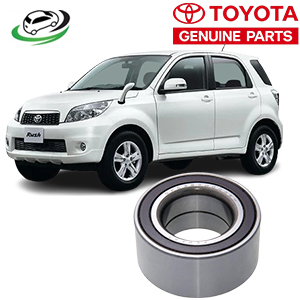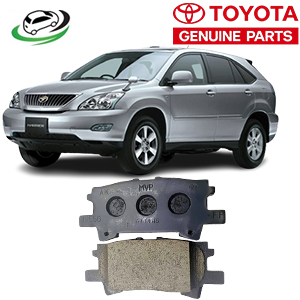-6%
Get Toyota Harrier ACU30W Rear Brake Pad Kit 04466 YZZAL
The rear brake pad kit is an essential component in your vehicle’s braking system. Its primary function is to provide the friction necessary to slow down or stop the vehicle by applying pressure to the brake rotor. A well-maintained brake pad kit ensures safe driving and optimal braking performance. In this guide, we will delve into the different types of rear brake pads, their functions, benefits, signs of wear, and tips for maintenance.
The Function of Rear Brake Pads
The rear brake pads, located within the brake caliper, press against the rear rotors when the brakes are applied. These pads are made of friction materials that convert the kinetic energy of the moving vehicle into thermal energy, effectively reducing the vehicle’s speed or bringing it to a stop. When you press the brake pedal, hydraulic fluid in the brake lines exerts pressure on the calipers, which then squeeze the brake pads against the rotors. This friction is what slows down the car.
Components of a Rear Brake Pad Kit
A typical rear brake pad kit includes several critical components:
- Brake Pads: The primary element, responsible for creating friction against the brake rotor.
- Anti-Rattle Clips: These prevent noise and vibration in the brake assembly.
- Backing Plates: These are metal plates that provide structural support to the brake pads.
- Shims: They help to reduce noise and vibrations by acting as a cushion between the brake pads and caliper.
- Wear Sensors: Some kits come with wear indicators that signal when the pads are due for replacement.
Types of Rear Brake Pads
There are four main types of brake pads, each with its unique composition and performance characteristics:
- Ceramic Brake Pads
- Composition: Made from ceramic fibers, bonding agents, and sometimes small amounts of metal.
- Benefits: Ceramic brake pads are known for their longevity, quiet operation, and minimal dust production. They can withstand high temperatures and are less prone to wear, making them ideal for everyday driving.
- Drawbacks: They tend to be more expensive than other types of brake pads and may not perform as well in extreme conditions, such as high-performance driving or heavy towing.
- Semi-Metallic Brake Pads
- Composition: These pads are made from a mixture of metal shavings (such as steel or iron) and other materials.
- Benefits: They offer excellent heat dissipation and are highly durable, making them ideal for high-performance or heavy-duty vehicles. Semi-metallic pads also provide good braking power in a wide range of temperatures.
- Drawbacks: They tend to be noisier and produce more brake dust, which can accumulate on wheels and affect the vehicle’s appearance.
- Organic Brake Pads (Non-Asbestos Organic, NAO)
- Composition: These are made from a mixture of organic materials, including rubber, carbon compounds, and fiberglass.
- Benefits: Organic brake pads are quieter than other types and produce less wear on brake rotors. They are also more environmentally friendly.
- Drawbacks: They tend to wear out faster, especially in high-performance conditions, and are less effective in extreme temperatures.
- Low-Metallic NAO Brake Pads
- Composition: A blend of organic materials and a small amount of metal, typically copper or steel.
- Benefits: These pads offer improved braking performance compared to fully organic pads and are more heat-resistant.
- Drawbacks: Like semi-metallic pads, they produce more brake dust and can be noisier.
Benefits of Using Quality Rear Brake Pads
- Enhanced Safety: High-quality brake pads provide consistent and reliable stopping power, which is crucial for vehicle safety. They reduce the stopping distance and ensure efficient braking in various driving conditions.
- Extended Rotor Life: Proper brake pads are designed to work harmoniously with your vehicle’s brake rotors. This reduces wear on the rotors, prolonging their lifespan.
- Reduced Noise and Vibration: Modern brake pads, especially those with integrated shims and anti-rattle clips, minimize noise and vibration during braking, providing a smoother driving experience.
- Improved Heat Resistance: Some brake pads are specifically designed to handle higher temperatures without degrading. This is especially beneficial for vehicles used in towing or high-performance scenarios.
- Lower Maintenance Costs: Quality brake pads last longer and reduce the frequency of replacements, which saves money in the long run.
Signs of Wear on Rear Brake Pads
Knowing when to replace your rear brake pads is crucial to maintaining your vehicle’s braking performance. Here are common signs that your brake pads are wearing out:
- Squealing or Squeaking Noise: This is often the first indication that your brake pads need replacement. Many brake pads are equipped with a wear indicator that produces a high-pitched sound when the pads are worn down.
- Reduced Braking Performance: If you notice that your vehicle takes longer to stop or the brake pedal feels spongy, it could be a sign that your brake pads are worn.
- Vibration or Pulsation: If the brake pads are unevenly worn or the rotors are warped, you might feel a vibration when applying the brakes.
- Visible Wear: If you can see the brake pads through the wheels, check for wear. Pads thinner than 3mm (1/8 inch) should be replaced.
- Brake Pad Warning Light: In some vehicles, the brake system is equipped with sensors that trigger a dashboard light when the pads are due for replacement.
Maintenance Tips for Rear Brake Pads
Proper maintenance of your rear brake pads can extend their lifespan and ensure optimal braking performance. Here are some tips:
- Regular Inspections: Have your brake pads inspected during regular vehicle maintenance. Checking them every 12,000 miles or annually, whichever comes first, is a good practice.
- Avoid Hard Braking: Hard or sudden braking, especially at high speeds, accelerates the wear of brake pads. Whenever possible, try to anticipate stops to apply gradual braking.
- Proper Bedding-In of New Pads: When you install new brake pads, follow the manufacturer’s recommendations for the bedding-in process. This involves gently braking multiple times to ensure an even layer of material is transferred to the rotors, which optimizes the performance and lifespan of the new pads.
- Keep Brake Components Clean: Dirt, dust, and debris can accumulate on brake components, reducing performance. Clean the brake assembly periodically to avoid premature wear.
- Replace Rotors as Needed: If the brake rotors are too worn or warped, they should be resurfaced or replaced when installing new brake pads to ensure even braking and prevent vibration.
Conclusion
A rear brake pad kit is a critical component of your vehicle’s braking system, ensuring safety and control on the road. Whether you opt for ceramic, semi-metallic, organic, or low-metallic NAO brake pads, regular maintenance and timely replacements are essential for reliable performance. By keeping an eye on the signs of wear and adhering to good driving habits, you can prolong the life of your rear brake pads and maintain optimal braking performance, contributing to both safety and cost efficiency.
Follow us on Facebook for more parts.




Reviews
Clear filtersThere are no reviews yet.